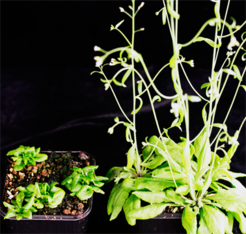Exploring the maintenance and diversity of plant immunity genes in nature
A study published by Alcazar et al in PLoS Genetics provides some important leads to the evolution of the immune system in European populations of Arabidopsis thaliana and mechanisms underlying the maintenance of particular immunity-related genes or allelic forms in nature.

In plants, naturally evolving disease resistance (R) genes can cause autoimmunity when combined with different genetic backgrounds. This phenomenon, called immune-related hybrid incompatibility (HI), leads to growth inhibition and fitness loss due to inappropriate activation of defenses. HI likely reflects different evolutionary paths of immune-related genes in nature but it is unclear whether these divergent trajectories are due to genetic drift or local adaptation. In this analysis, Ruben Alcazar and colleagues have examined the genetic architecture of a complex R locus present in an Arabidopsis Central European accession (Landsberg) which underlies HI with accessions from Central Asia. The authors show that expression of one gene (R3) within the Landsberg cluster of eight tandem R genes (R1-R8) controls the balance between growth and defense but that R3 needs at least one other co-acting member within the R locus to condition HI. Interestingly, the R1-R8 haplotype was traced back to a local population of Landsberg relatives in the village of Gorzów Wielkopolski in Poland, where it also underlies HI with Arabidopsis Central Asian accessions. The occurrence of the incompatible haplotype in ~30% of genetically diverse Gorzów local Arabidopsis individuals, suggests that it has not arisen recently as result of a bottleneck but has been maintained through selection or drift over several decades at least. The co-occurrence in the same Gorzów population of individuals that contain different R genes not causing HI provides a basis for determining the genetic, environmental, and potentially ecological forces influencing how plant immunity genes evolve and diversify in nature at local population scales.
